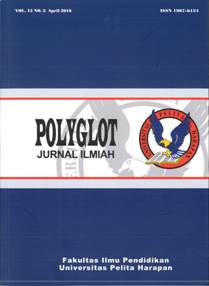The Teacher’s Role in Supporting the ZPD in Students’ English Oral Communication Skills based on the PYP Language Scope and Sequence of Grade EY 3A: A Case Study
DOI:
https://doi.org/10.19166/pji.v12i2.362Kata Kunci:
language, oral communication, communication skills, PYP, ZPD, komunikasi lisan, dua bahasa, IB Curriculum, PYP Language Scope and Sequence, Zone of Proximal DevelopmentAbstrak
With many international schools implementing bilingual systems in their teaching learning activities, different students who come from different family backgrounds may apply bilingual communication, both at school and at home. For the classroom teacher, one approach to support students’ oral communication skills is through supporting the Zone of Proximal Development (ZPD). In order to make the ZPD happen in the classroom, particularly in the students’ speaking skills, the classroom teacher needs to apply some strategies. The research was descriptive qualitative and the tools used to collect data in the study were in the form of observations, interviews and field notes. The results of the research indicate there are six strategies that the classroom teacher used to support the ZPD. Besides that, there were five aspects that the classroom teacher did to support the students’ oral communication skills and based on the PYP Language Scope and Sequence, the students demonstrated various common trends in their oral communication skills.
BAHASA INDONESIA ABSTRAK: Dengan banyaknya sekolah Internasional yang menerapkan sistem dwibahasa dalam aktivitas belajar mengajar, peserta didik yang berasal dari latar belakang keluarga yang berbeda berkomunikasi menggunakan dua bahasa, baik di sekolah maupun di rumah. Bagi guru kelas, pendekatan yang bisa digunakan untuk mendukung keterampilan berkomunikasi lisan siswa adalah dengan mendukung Zone of Proximal Development (ZPD). Agar ZPD dapat berjalan di kelas, terutama di keterampilan berbicara siswa, guru kelas perlu menerapkan beberapa strategi. Penelitian ini adalah deskriptif kualitatif dan alat yang digunakan untuk mengumpulkan data dalam penelitian ini dalam bentuk observasi, wawancara dan catatan lapangan. Hasil penelitian mengindikasikan ada enam strategi yang diterapkan guru kelas untuk mendukung Zone of Proximal Development. Di samping itu, ada lima aspek yang dilakukan guru kelas untuk mendukung keterampilan berkomunikasi lisan siswa dan berdasar PYP Language Scope and Sequence, siswa menunjukkan berbagai macam tren yang muncul pada umumnya.
Referensi
Bennett-Armistead, V. S., Duke, N. K., & Moses, A. M. (2005). Literacy and the youngest learner: Best practices for educators of children from birth to five. New York: Scholastic.
Dickinson, D. K., & Tabors, P. O. (2002). Fostering language and literacy in classrooms and homes. Young Children, 57(2), 10.
International Baccalaureate Organization. (2009). Primary Years Programme Language scope and sequence. Cardiff, Wales: IBO.
Lamb, M. E., & Lerner, R. M. (Eds.). (2015). Handbook of child psychology and developmental science: Vol. 3. Socioemotional processes (7th ed.). Hoboken, NJ: Wiley.
Lockhart, S. (2011). Play: An important tool for cognitive development. HighScope Extensions, 24(3), 1-8.
Lockhart, S. (2012). Benefits of listening to stories and reading aloud. HighScope Extensions, 26(3) 11-12.
Lui, A. (2012). Teaching in the zone. Children's Progress. Retrieved from http://sowamslibrary.weebly.com/uploads/2/3/0/7/23079404/teaching_in_the_zone.pdf
Prihartini, A. I. (2012). Teacher's Role In PYP Language Curriculum Implementation To Develop Early Childhood Oral Communication: A Case Study At Sekolah International X Jakarta Selatan. Jakarta.
Santrock, J. W. (2009). Educational psychology. New York: McGraw-Hill.
Steward, E. P. (2009). Beginning writers in the zone of proximal development. New York: Routledge.
Wardle, F. (2003). Introduction to early childhood education: A multidimensional approach to child-centered care and learning. Boston: Pearson Education.
Unduhan
Diterbitkan
Terbitan
Bagian
Lisensi
Authors who publish with this journal agree to the following terms:
1) Authors retain copyright and grant the journal right of first publication with the work simultaneously licensed under a Creative Commons Attribution License (CC-BY-SA 4.0) that allows others to share the work with an acknowledgement of the work's authorship and initial publication in this journal.
2) Authors are able to enter into separate, additional contractual arrangements for the non-exclusive distribution of the journal's published version of the work (e.g., post it to an institutional repository or publish it in a book), with an acknowledgement of its initial publication in this journal.
3) Authors are permitted and encouraged to post their work online (e.g., in institutional repositories or on their website). The final published PDF should be used and bibliographic details that credit the publication in this journal should be included.





